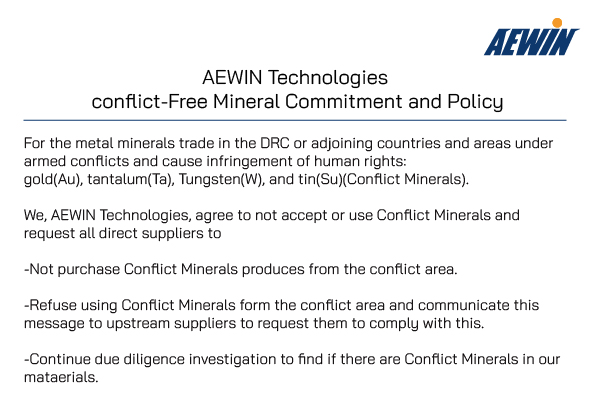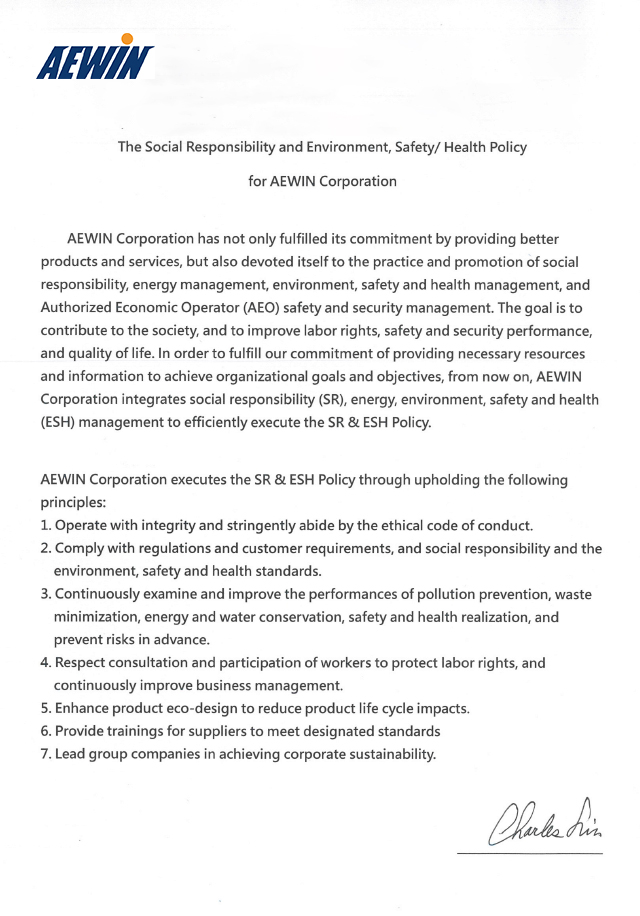C1
.
Commitment and Policy
We are committed to hold that “Caring for the Earth, fulfilling the Promise of CSR (Corporate social responsibility), offering customer satisfaction guaranteed service and creating a Healthy Workplace Environment” as the guideline for our corporate culture.
Our polices:
For Quality – sticks to excellent quality and thoughtful service
For HSF: regulatory compliance, green products and continual improvement process
C2
.
HSF Management(Hazardous Substances Free)
HSF
In 2011, we purchased the XRF hazardous substance inspection equipment to prevent hazardous substances from contaminating products. In 2013 we passed IECQ QC080000 HSPM (Hazardous Substances Process Management) system certification to strengthen hazardous substance management, so as to achieve the hazardous-substance-free (HSR) target in all processes from product design to process contamination prevention.
We continuously pay attention to international environmental regulations and combine relevant legal and regulatory requirements with our hazardous substance management regulations to minimize the use of hazardous substances, reduce impacts on the environment, and protect the earth, the environment and human health.
Our HSF Management Policy:
Customer satisfaction, legal compliance, green product, and continual improvement.
RoHS requirements
At AEWIN, we have been voluntarily implementing environmental protection to complywith the RoHS requirements. In product, part and process development, lead (Pb), cadmium (Cd), mercury (Hg), hexavalent chromium (Cr6+), polybrominated biphenyls (PBBs), and polybrominated diphenyl ethers (PBDEs) have been banned. Since July 2006 all AEWIN products comply with the RoHS requirements.
Commission Delegated Directive (EU) 2015/863 of 31 March 2015 amending to Directive 2011/65/EU of the European Parliament and of the Council as regards the list of restricted substances (Text with EEA relevance), including Bis(2-ethylhexyl)phthalate(DEHP)、Butyl benzyl phthalate(BBP)、Dibutyl phthalate(DBP)、Diisobutyl phthalate(DIBP). After assessing the differences between both versions, we have amended and updated our hazardous substances management regulations accordingly to ensure that our technology and process can continuously comply with the latest RoHS requirements.
Major contents of the directive 2011/65/EU of the European Parliament and of the Council of 8 June 2011 on the restriction of the use of certain hazardous substances in electrical and electronic equipment Text with EEA relevance.
The scope and variety of products where RoHS is applied have been expanded in the new version. RoHS is also applied to the product conformity of CE marking. The RoHS 2 superseded the RoHS (2002/95/EC) as of 3 January 2013.
REACH Directive
What is REACH?
REACH is the abbreviation for the Regulation for Registration, Evaluation, Authorization and Restriction of Chemicals. REACH was made effective as of 1 June 2007 to “ensure a high level of protection of human health and the environment” and request compliance with its registration, evaluation, authorization and restriction requirements for chemical substances (pure substances, mixtures and articles) specified in the regulation. Otherwise, products will be banned from sales, manufacture or use in the EU and member states.
Registration duty
Referring to 1 of Article 7 of REACH, “Registration and notification of substances in articles”: Any producer or importer of articles shall submit a registration to the Agency for any substance contained in those articles, if both the following conditions are met:
(a) the substance is present in those articles in quantities totaling over 1 ton per producer or importer per year;
(b) the substance is intended to be released under normal or reasonably foreseeable conditions of use.
After assessment based on these requirements, our team validates that substances contained in products design and manufactured by AEWIN will not be released under normal or reasonably foreseeable conditions of use after assessment and validation. Therefore, we can be exempted from the registration duty.
Notification duty
Referring to 2 of Article 7 of REACH, “Registration and notification of substances in articles”: Any producer or importer of articles shall notify the Agency…if [products containing substances of very high concern for authorization (SVHC) announced by the ECHA and] both the following conditions are met:
(a) the substance is present in those articles in quantities totaling over 1 ton per producer or importer per year;
(b) the substance is present in those articles above a concentration of 0.1 % weight by weight (w/w).
After assessing and examining the parts and components used in products, our team validates that AEWIN products do not contain SVHC exceeding 0.1% (w/w). When the ECHA updates the SVHC items, we will re-assess and re-examine our products to ensure no SVHC is contained.
Other International Environmental Regulations
EU Directive on Packaging and Packaging Waste (94/62/EC)
The EU Directive on Packaging and Packaging Waste was made effective as of February 2003 to request (1) package design of products should comply with the minimum use of packaging materials, (2) packaging materials are reusable and recyclable, and (3) heavy metals contained in packaging materials should not exceed relevant standards. Under this directive, packaging materials include:
Sales packaging: Packaging conceived so as to constitute a sales unit to the final user or consumer at the point of purchase
Grouped packaging: Packaging conceived so as to constitute a grouping of a certain number of sales units for temporary storage or short-distance delivery.
Transport packaging: Packaging conceived so as to facilitate long-distance transport or warehousing.
Limit on heavy metal contents: Lead + mercury + cadmium + Cr6+ totaling under 100ppm
EU battery directive (2006/66/EC)
Made effective as of 26 September 2008, the directive requests that all batteries must comply with the labeling requirements and heavy metal limits so as to be sold and used in the EU.
Heavy metal limits
The mercury content of all batteries or accumulators must be under 0.0005% (by weight).
The cadmium content of all portable batteries or accumulators must be under 0.002% (by weight).
China RoHS (Administrative Measure on the Control of Pollution Caused by Electronic Information Products)
Referring to relevant definitions and regulations of relevant of the PRC electronics industry regulations, electronic information products should comply with the limit on relevant hazardous substances such as lead, mercury, cadmium, Cr6+, PBBs, and PBDEs and with the Marking for Control of Pollution Caused by Electronic Information Products.
Restriction of the Use of Certain Hazardous Substances in Electronic and Electrical Equipment (2011/65/EU)
It aims to prevent hazardous substances from entering the production process and thereby keep them out of the waste stream.
Restriction of Hazardous Substances (EU 2015/863)
On June 4, 2015, the EU Commission published new Directive (EU) 2015/863 which adds 4 phthalate substances to the list of 6 already in RoHS II. These phthalates will be restricted from use starting July 22, 2019 from most EEE. Includes: Bis(2-ethylhexyl)phthalate(DEHP)、Butyl benzyl phthalate(BBP)、Dibutyl phthalate(DBP)、Diisobutyl phthalate(DIBP).
C3
.
Conflict Minerals
Conflict Minerals
As a professional industrial PC designer and manufacturer, to ensure that the source and process of raw materials involve no environmental or social issues has always been our prime concern, particularly for mineral resources extracted from the Democratic Republic of the Congo (DRC) and adjoining countries. As mines in the DRC and adjoining countries are controlled by armed rebels or local profit groups which often make profits from forcing or compelling local citizens or child labor to mine with violence, threats and behaviors against human rights or from illegal mineral trade, conflict minerals are very likely to encourage certain kinds of terrorist activities which may result in unpredictable severe damage.
Therefore, we have established the “Conflict Minerals Management Policy” and investigated upstream suppliers. We have also effectively communicated this concept to all partner suppliers to contribute our part to international social and environmental issues.

C4
.
The Social Responsibility and Environment, Safety/ Health Policy
AEWIN Corporation has not only fulfilled its commitment by providing better products and services, but also devoted itself to the practice and promotion of social responsibility, energy management, environment, safety and health management, and Authorized Economic Operator (AEO) safety and security management. The goal is to contribute to the society, and to improve labor rights, safety and security performance, and quality of life. In order to fulfill our commitment of providing necessary resources and information to achieve organizational goals and objectives, from now on, AEWIN Corporation integrates social responsibility (SR), energy, environment, safety and health (ESH) management to efficiently execute the SR & ESH Policy.
AEWIN Corporation executes the SR & ESH Policy through upholding the following principles:
- Operate with integrity and stringently abide by the ethical code of conduct.
- Comply with regulations and customer requirements, and social responsibility and the environment, safety and health standards.
- Continuously examine and improve the performances of pollution prevention, waste minimization, energy and water conservation, safety and health realization, and prevent risks in advance.
- Respect consultation and participation of workers to protect labor rights, and continuously improve business management.
- Enhance product eco-design to reduce product life cycle impacts.
- Provide trainings for suppliers to meet designated standards
- Lead group companies in achieving corporate sustainability.
